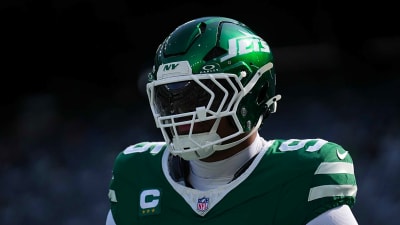
When a team starts 0-5, it is usually because multiple critical players are underperforming.
Many players have underperformed for the sputtering New York Jets in 2025. Of those, the most disappointing might be second-year left tackle Olu Fashanu.
Chosen 11th overall by New York in the first round of the 2024 NFL draft, Fashanu was tabbed as the Jets’ blindside protector of the future. His rookie year got off to a rocky start as injuries to other starters forced him to play out of position, but once Fashanu got to settle in at his natural left tackle spot later in the year, he set a strong foundation to build off of.
It seemed as if Fashanu, a 22-year-old athletic specimen, was on the verge of a breakout year in 2025. Unfortunately for the Jets, that has been far from the case. As things stand, Fashanu is the most significant liability on New York’s offensive line.
According to Pro Football Focus, Fashanu has been charged with allowing a team-high 18 total pressures this season, the most in the NFL among left tackles. He’s allowed those pressures on 203 pass-blocking snaps.
It’s a jarring increase compared to his rookie year, when Fashanu allowed just 12 total pressures on 230 pass-blocking snaps at left tackle. This year, he has allowed six more pressures on 28 fewer pass-blocking snaps.
Fashanu’s allowed pressure rate has spiked from 5.2% to 8.9%. For perspective, the league average for tackles this season is 6.6%. Essentially, Fashanu has regressed from comfortably above-average to well below-average.
This past Sunday’s game against the Dallas Cowboys was a perfect chance for Fashanu to steer his sophomore season in the right direction. Fashanu was coming off a season-best performance against the Miami Dolphins in Week 4, allowing one pressure on 39 pass-blocking snaps. Dallas was a favorable opponent for Fashanu to build on those numbers, as the Cowboys’ edge rushers were poor through the first four games of the season.
Instead of seizing the opportunity, Fashanu allowed the Cowboys’ previously dormant edge rushers to have their most explosive game of the season. Fashanu yielded five pressures on 56 pass-blocking snaps (8.9% pressure rate). He particularly struggled against Dante Fowler Jr., who finished the game with a season-high six pressures after posting eight over the first four games combined.
Fashanu allowed Fowler to knock down Justin Fields three times.
It was too soon to start panicking about Fashanu through three or four games. He even seemed to be trending up after the Miami game. But after responding to his one step forward by taking an even bigger step back—getting exposed at home against lackluster competition—it’s time to sound the alarms.
Fashanu was supposed to anchor a Jets offensive line with high hopes in 2025. Manning the most valuable position on the line, Fashanu had the potential to break out as a top-10 left tackle this year.
Now, the Jets would be thrilled if Fashanu could just string together some passable performances.
In fairness to Fashanu, it is difficult to evaluate the Jets’ offensive line this season because of the quarterback play.
With Justin Fields averaging 3.24 seconds to throw in 2025 (second among quarterbacks) and Tyrod Taylor not much faster at 3.07 seconds, the offensive linemen’s stats are skewed. They have been charged with allowing pressures on many plays where most other quarterbacks would have already gotten the ball out.
Compare those numbers to the 2024 season, when Fashanu and the Jets’ offensive linemen benefited from Aaron Rodgers’ 2.65-second average. Rodgers may have struggled overall, but he definitely helped improve the offensive linemen’s individual stats by sparing them from having to block for very long.
Going from Rodgers to Fields is a night-and-day shift for the line to deal with. It’s unsurprising that the spike in time-to-throw has been accompanied by worse pass-blocking stats.
Fashanu and the Jets’ other linemen have not been as bad as certain metrics suggest. But it doesn’t let him off the hook.
Playing on the same line, rookie right tackle Armand Membou has yielded five fewer pressures than Fashanu this season, while rating significantly better in metrics like PFF’s pass-blocking grade and ESPN’s pass-block win rate. The eye test also paints Membou as a more impactful player.
Whether Fashanu has been “poor” or merely “below-average” is a matter of subjectivity due to the challenge of evaluating New York’s linemen independent of the quarterbacks, but we can say with certainty that Fashanu has not been a net-positive. The Jets need him to return to his initial development track as soon as possible.
Fashanu is still a rookie in many ways. At 22 years old, he was born later than multiple first-round offensive linemen from the 2025 draft class. Most importantly, because of his late rookie-year transition to left tackle and injuries late in the season, he has only made 10 career starts at left tackle.
The Nittany Lion’s story is far from written. Still, as the Jets scramble for increased production from anywhere they can find it, Fashanu remains one of their best sources of potential improvement. This is a player who has been a net-negative so far, but is also a first-round talent with top-10 upside at a premium position. There is substantial room for the Jets to squeeze newfound value out of him over the rest of the year.
To turn their season around, the Jets need as many of these in-season development stories as they can get. Fashanu is one of their best candidates to pull it off.
More must-reads:
- Where shocking trade-deadline fire sale leaves Jets moving forward
- Yankees offseason blueprint: Best-case lineup scenario features Bo Bichette, Kyle Tucker
- The '2025 backup NFL quarterbacks' quiz
Breaking News
Trending News
Customize Your Newsletter
 +
+
Get the latest news and rumors, customized to your favorite sports and teams. Emailed daily. Always free!








